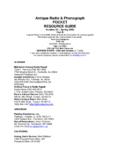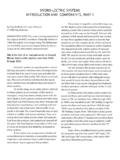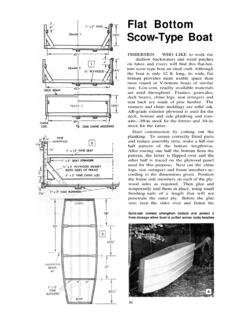Transcription of Using the Transit - Antique Surveying
1 Using the Transit David White Instruments Realist TR-300 " Transit Telescope in normal reading orientation Cross-hair focus Compass Upper tangent screw Upper clamp Vertical clamp Focus Vertical tangent screw Lower clamp & tangent screw Vertical circle& vernier Plate levels Capstan screws: top bottom Horizontal circle & vernier Leveling screws Upper clamp & tangent screw 2 Checklist Transit in orange box. In the case should also be a plumbob and a 5/64" drill bit or the original adjustment tools a magnifying glass for reading the vernier Tripod with cm wide screw-on mount. Stadia rod with rod level. Tape if desired. Survey pins if desired. Setup 1. Set up tripod, getting the top close to horizontal.
2 2. Carefully mount Transit on tripod, as close as possible to over the survey point. 3. Level in two directions Using the plate levels, each in line with opposite pairs of leveling screws. Rotate horizontal circle 180 to check if bubbles stay level. If necessary try again from this position. If you cannot get the bubble to stay centered 180 apart, you'll need to adjust the plate level (see the instructions). This is commonly needed, so make sure you have the tool that exactly fits the adjustment screws. 4. To position the Transit exactly over a survey point Using the plumbob, after leveling you'll need to loosen two adjacent leveling screws to be able to move the Transit on the tripod plate. You can only move it a short distance you may need to reposition your tripod and relevel if you're off by more than that.
3 Then level it again. 5. Once leveled with the plate level, you can level to greater accuracy with the telescope bubble: Bring the telescope over a pair of leveling screws and center the telescope bubble by Using the vertical clamp and tangent screw. Rotate the telescope 180 in azimuth. If the telescope bubble does not come to the center, bring it halfway to the center by turning the vertical Adjusting a plate bubble level After centering the bubble in one position, rotate the horizontal circle 180 and if this is off you need to adjust that plate level: Use the leveling screws to correct the bubble half way to center, then: Use the smooth part of a 5/64" drill bit, or the tool to adjust one or the other side of the plate level up or down to get the bubble centered.
4 You'll be turning the top and bottom capstan screws the same direction to move that side of the bubble up (counter-clockwise) or down (clockwise). Note that you have to turn one to loosen it, and the other the same direction to tighten it, in a new position. If it's off very much at all, you'll have to repeat this to get it closer and closer. Clamps and tangent screws clamp tangent screw There are three clamp and tangent screw pairs: two (upper and lower) for horizontal circle adjustments, and one for vertical. In each case, the clamp is loosened to move the Transit more than a few degrees, then the clamp is tightened for fine adjustment with the tangent screw 3tangent screw, and then center the bubble by Using the two leveling screws.
5 Rotate the telescope again 180 in azimuth. The bubble should remain centered. If it does not, repeat the process of bringing it halfway to center with the tangent screw and the rest of the way with the leveling screws. When the bubble remains centered after the telescope is rotated, bring the telescope over the other pair of leveling screws and bring the bubble to center by Using the leveling screws only. This makes the vertical axis of the Transit truly vertical. You may still have an error if the sighting is not parallel with the telescope bubble, or the vertical vernier is off. You can detect this by making two sightings of the same distant feature with the telescope in normal position and reverted position (rotate the telescope vertically so the telescope bubble is on top) and comparing the readings.
6 Part of this can be fixed by adjusting the telescope bubble level, but the remaining index error (see below) is probably best resolved by making two readings, normal and reversed. 6. Get the Transit reading magnetic or true azimuths (though absolute accuracy is limited by the compass to about a degree with transits and theodolites the absolute accuracy is not as important as the relative accuracy of angles) by: Using the upper clamp and tangent screw to set the direction to zero. You'll need to understand how to read the horizontal circle vernier. The lower scale shows the reading to a half degree; the upper shows the minutes above or below that reading. For minutes find which mark lines up with a degree or half degree mark below.
7 The figure shows a reading of 33 45'. For now though, you just need to put the zero on the zero, but check the vernier to make sure the 0 mark is lined up with the 0' mark. With the upper clamp closed, and the compass released (unscrew its lock until it moves freely) open the lower clamp to rotate the telescope until the north arrow is pointing to north on the scale, or to the magnetic declination (may be around ) to get true directions. Then close the lower clamp. 4 Reading horizontal azimuths From now on when you rotate the telescope with the upper clamp open, or fine adjust the upper tangent screw, you'll get readings in azimuths. You can get angles by subtracting one angle from another. Reading vertical angles Also uses a vernier to get degrees and minutes.
8 The reading below is 0 04'. Note that the minutes are now on the bottom, in contrast to the horizontal circle a potential source of confusion and blunder. A single reading may be off by 10' or more. To get a more accurate reading to a minute average two readings: (1) the normal reading, and (2) a reversed reading, with the telescope reversed 180 in azimuth and the telescope plunged (rotated vertically 180 so that the telescope bubble is on top). Half of the difference is the index error, which should remain reasonably consistent during a given use, so you could also add this index error to the normal reading instead of making two readings; but it's probably a good idea to check this on multiple readings. Reading distances, Using the stadia rod If reading is at level, the stadia readings can be converted to distances by subtracting the lower from the upper stadia reading and multiplying the resulting difference (s) by the stadia interval factor (K) to get distance: H = Ks.
9 K should be approximately 100, but you can derive a more accurate value by previously calibrating Using a known horizontal distance your derived K should be recorded on paper and kept with the instrument. If you're not reading a level reading, you can use the following formula to get horizontal distance Using the vertical angle a: H = Ks cos(a) cos(a) This is the general formula for any angle including zero, which should make sense as cos(0) = 1.




